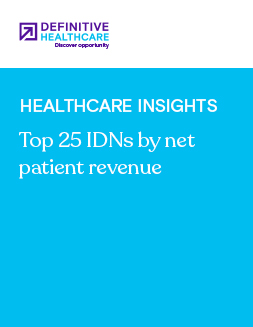Healthcare Insights
Top 15 ophthalmology procedures
Everyone knows someone with vision issues. If you require glasses or corrective lenses, you are one of many Americans with a visual impairment.
According to the CDC, approximately 12 million people 40 years and over in the United States have vision impairment, and vision disability is one of the top 10 disabilities among adults 18 years and older.
Keep reading to explore the most common ophthalmology procedures based on CPT codes with the highest procedure volume.
| Rank | HCPCS/CPT code | HCPCS/CPT description | # of total procedures | Explore dataset |
|---|---|---|---|---|
| 1 | 92014 | Ophthalmological services: medical examination and evaluation, with initiation or continuation of diagnostic and treatment program; comprehensive, established patient, 1 or more visits | 9,856,359 | Explore |
| 2 | 92015 | Determination of refractive state | 7,246,943 | Explore |
| 3 | 92134 | Scanning computerized ophthalmic diagnostic imaging, posterior segment, with interpretation and report, unilateral or bilateral; retina | 6,689,858 | Explore |
| 4 | 92012 | Ophthalmological services: medical examination and evaluation, with initiation or continuation of diagnostic and treatment program; intermediate, established patient | 4,307,995 | Explore |
| 5 | 92004 | Ophthalmological services: medical examination and evaluation with initiation of diagnostic and treatment program; comprehensive, new patient, 1 or more visits | 3,756,810 | Explore |
| 6 | 92250 | Fundus photography with interpretation and report | 3,277,641 | Explore |
| 7 | 92133 | Scanning computerized ophthalmic diagnostic imaging, posterior segment, with interpretation and report, unilateral or bilateral; optic nerve | 2,844,095 | Explore |
| 8 | 92083 | Visual field examination, unilateral or bilateral, with interpretation and report; extended examination (e.g., Goldmann visual fields with at least 3 isopters plotted and static determination within the central 30 deg, or quantitative, automated threshold perimetry, octopus program g-1, 32 or 42, Humphrey visual field analyzer full threshold programs 30-2, 24-2, or 30/60-2) | 2,842,843 | Explore |
| 9 | 92136 | Ophthalmic biometry by partial coherence interferometry with intraocular lens power calculation | 1,709,748 | Explore |
| 10 | 92020 | Gonioscopy(separate procedure) | 860,760 | Explore |
| 11 | 92340 | Fitting of spectacles, except for aphakia; monofocal | 606,217 | Explore |
| 12 | 92202 | Ophthalmoscopy, extended; with drawing of optic nerve or macula (e.g., for glaucoma, macular pathology, tumor) with interpretation and report, unilateral or bilateral | 562,114 | Explore |
| 13 | 92201 | Ophthalmoscopy, extended; with retinal drawing and scleral depression of peripheral retinal disease (e.g., for retinal tear, retinal detachment, retinal tumor) with interpretation and report, unilateral or bilateral | 529,065 | Explore |
| 14 | 92060 | Sensorimotor examination with multiple measurements of ocular deviation (e.g., restrictive or paretic muscle with diplopia) with interpretation and report (separate procedure) | 439,208 | Explore |
| 15 | 92310 | Prescription of optical and physical characteristics of and fitting of contact lens, with medical supervision of adaptation; corneal lens, both eyes, except for aphakia | 439,088 | Explore |
Fig 1. Data is from the Definitive Healthcare ClaimsMx product. Data represents full calendar year 2021. Claims data is sourced from multiple medical claims clearinghouses in the United States and is updated monthly. Data is accurate as of April 2022.
Which ophthalmology procedure was performed the most in 2021?
Unsurprisingly, the most common ophthalmology procedure is CPT 92014 for an eye examination and evaluation as part of a diagnostic or treatment program for established patients, with nearly 10 million procedures performed in 2021. In other words, the top procedure is a comprehensive eye examination for existing patients who have already seen the provider for vision issues.
Taking the second spot is CPT 92015 for the determination of refractive state. This code is frequently billed under CPT 92014. Refractive errors are the most frequent eye problems in the United States. If you are near-sighted, farsighted or have astigmatism, you have a refractive error. Determining the refractive state is necessary for anyone seeking glasses or corrective lenses.
Rounding out the top three is CPT 92134 for computerized ophthalmic diagnostic imaging to examine the retina for disease. This procedure is beneficial for detecting diseases such as glaucoma, age-related macular degeneration, retinal detachment and diabetic retinopathy – some of the most common eye diseases.
What is ophthalmology?
Ophthalmology deals with the diagnosis and treatment of eye disorders. Ophthalmologists complete specialized training and are licensed to practice medicine and surgery.
What is the difference between an ophthalmologist and an optometrist?
Ophthalmologists are medical doctors who have advanced training to diagnose and treat a broader range of eye and vision issues than an optometrist. Ophthalmologists also perform eye surgeries.
Ophthalmologists can diagnose and treat all eye diseases, but some will specialize further in a particular medical or surgical eye care area. Common subspecialty areas for ophthalmologists include glaucoma, retina, cornea and pediatrics.
On the other hand, Optometrists are eye care professionals who provide primary vision care to patients. They are not medical doctors and instead have a Doctor of Optometry (OD) degree. They typically perform eye exams and vision tests, prescribe and dispense corrective lenses, detect and diagnose certain eye abnormalities and prescribe prescriptions for eye conditions.
Learn more
Healthcare Insights capture a small slice of the massive amount of healthcare commercial intelligence available on the Definitive Healthcare platform. Want to see the full picture? Start a free trial today and get access to the latest healthcare commercial intelligence on hospitals, physicians, diagnoses, technologies and more.



